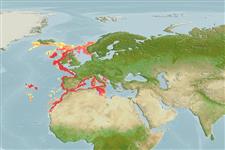>
Eupercaria/misc (Various families in series Eupercaria) >
Sparidae (Porgies)
Etymology: Pagellus: Diminutive of Latin, pager, derived from Greek, pagros = a fish, Dentex sp. (Ref. 45335).
Environment: milieu / climate zone / depth range / distribution range
Ecologia
marinhas bentopelágico; intervalo de profundidade 150 - 700 m (Ref. 56504), usually 150 - 300 m (Ref. 35388). Temperate; 65°N - 20°N, 32°W - 37°E
Eastern Atlantic: Norway, Strait of Gibraltar to Cape Blanc in Mauritania, Madeira, Canary Islands, and western Mediterranean (rare beyond the Sicilian Strait). Reported from Iceland (Ref. 12462).
Comprimento de primeira maturação / Tamanho / Peso / Idade
Maturity: Lm 31.4 range ? - ? cm
Max length : 70.0 cm SL macho/indeterminado; (Ref. 4781); common length : 30.0 cm SL macho/indeterminado; (Ref. 4781); peso máx. publicado: 4.0 kg (Ref. 9987); idade máx. registrada: 15 anos (Ref. 4645)
Espinhos dorsais (total) : 12 - 13; Raios dorsais (total) : 11 - 13; Espinhos anais: 3; Raios anais : 11 - 12. Black spot above the pectoral fin base. Snout shorter than the eye diameter (Ref. 35388).
Inshore waters above various types of bottom (rocks, sand, mud) to 400 m (Mediterranean) and 700 m (Atlantic); young near the coast, adults on the continental slope specially over muddy bottoms. Omnivorous, but feed mainly on crustaceans, mollusks, worms and small fish. Protandric hermaphrodites, become females at 20-30 cm length. Adults move towards the coast up to the edge of the continental shelf to spawn from January to June (Ref. 3688). Important foodfish. Marketed fresh and frozen; consumed pan-fried, broiled and baked (Ref. 9987).
Protandric hermaphrodite species (male during its first sexual maturity). Becomes female between 2 and 7 years of age. Spawns from January to June, depending on latitude. Egg size 1.19 mm, larval length at hatching 3.7 mm. Simultaneous hermaphroditism is also suggested for this species (Ref. 103751).
Bauchot, M.-L. and J.-C. Hureau, 1990. Sparidae. p. 790-812. In J.C. Quero, J.C. Hureau, C. Karrer, A. Post and L. Saldanha (eds.) Check-list of the fishes of the eastern tropical Atlantic (CLOFETA). JNICT, Lisbon; SEI, Paris; and UNESCO, Paris. Vol. 2. (Ref. 3688)
Status na Lista Vermelha da UICN (Ref. 130435)
Ameaça para os humanos
Harmless
Uso pelos humanos
Pescarias: espécies comerciais; peixe esportivo: sim
Ferramentas
Relatórios especiais
Baixar XML
Fontes da internet
Estimates based on models
Preferred temperature (Ref.
123201): 6.9 - 14.9, mean 11.2 °C (based on 160 cells).
Índice de diversidade filogenética (Ref.
82804): PD
50 = 0.5156 [Uniqueness, from 0.5 = low to 2.0 = high].
Bayesian length-weight: a=0.01096 (0.00968 - 0.01242), b=3.03 (3.00 - 3.06), in cm total length, based on LWR estimates for this species (Ref.
93245).
Nível Trófico (Ref.
69278): 4.2 ±0.6 se; based on diet studies.
Generation time: 8.5 (6.5 - 9.3) years. Estimated as median ln(3)/K based on 15
growth studies.
Resiliência (Ref.
120179): médio(a), tempo mínimo de duplicação da população 1,4 - 4,4 anos (K=0.09-0.1; tmax=15; tm=4-5; Fec=70,000).
Prior r = 0.51, 95% CL = 0.34 - 0.77, Based on 4 full stock assessments.
Fishing Vulnerability (Ref.
59153): High vulnerability (64 of 100).
Climate Vulnerability (Ref.
125649): Moderate to high vulnerability (45 of 100).
Nutrients (Ref.
124155): Calcium = 41.2 [17.9, 69.5] mg/100g; Iron = 0.167 [0.103, 0.268] mg/100g; Protein = 19.5 [18.2, 20.8] %; Omega3 = 0.742 [0.486, 1.122] g/100g; Selenium = 47.9 [24.1, 97.4] μg/100g; VitaminA = 10.4 [2.1, 53.0] μg/100g; Zinc = 0.275 [0.208, 0.378] mg/100g (wet weight); based on
nutrient studies.
